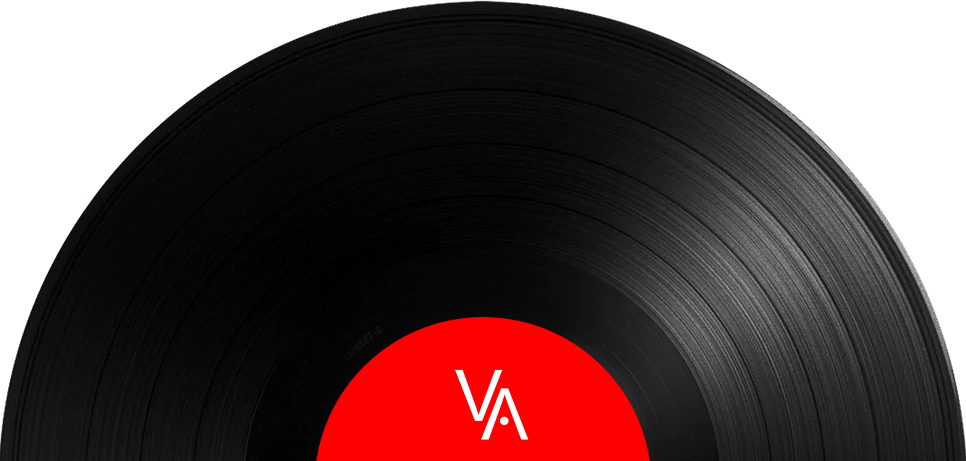
Gyn Johns, who produced this record, has stated it's the best record he's ever worked on. I'm not sure when he said this, but even if it was decades ago I can't imagine his opinion would change much if he said it now. Joan Armatrading is the self-titled and third LP released by its namesake, and it's the one that set her on her way.
Down To Zero, Love & Affection … everyone knows and loves these songs, and this particular pressing is from the good folks at Intervention Records, who are dedicated to putting out some of the absolute best reissues on the planet. This is one of their very best - perfectly flat and quiet vinyl, and the sound is stunning. I've never heard a better pressing of this record. The arrangements place the instruments - horns, keyboards, strings, whatever - right here in the room with me. The horns on Help Yourself sound, simply, beautiful. What could have sounded bunched up and overblown is instead airy and transparent. You can actually feel this spaciousness of this pressing.
Love & Affection is one of those songs that, the first time you heard it, you stopped whatever you were doing and listened. I know that's what you did because that's what everybody else did, too. The opening line - "I am not in love, but I'm open to persuasion … " is an astonishingly honest revelation for a 25-year-old black, closeted-gay woman in the 1970s. You immediately knew it was a song destined for greatness, one that would last forever and sound just as fresh and honest a hundred years hence. It spoke to a part of you. You could identify with something in that song, some word or chord, or possibly a clever combination of both. It's quite literally magic, and the deep baritone voice of Clarke Peters is one of those magical moments that gives the song added depth and a sense of playfulness and sends a shiver along my spine every time I listen to the song. Clarke Peters, by the way, long ago moved from singing backup on records into an acting career and is now an award-winning actor who has appeared in such notable TV dramas as The Wire (Detective Lester Freamon), Treme (Albert Lanbreaux), Blue Bloods, True Detective, Death In Paradise … the list of his TV and movie credits is extensive, and I know you'll look at him differently now, knowing that he's also "that voice" on "that song".
This is such an exceptional grouping of musicians. There isn't a bum note anywhere. Armatrading certainly knows her way around an acoustic guitar, and she also knew who to bring in to help fill out and shape her vision. The electric guitar riffs Jerry Donahue inserts into People are delicious. He's just great wherever he shows up, and his slide work on Like Fire is especially tasty. Peter Wood's piano and organ on Join The Boys is wonderful and really pushes the song's edges further out. The group is rounded out by Dave Mattacks on drums, Dave Markee on bass, Jimmy Jewell on alto sax and additional background vocals provided by Leroy Champaign. Nobody overplays their welcome. There are no egos on display here. Everybody contributes exactly the right amount of talent, in exactly the right places. This is one of those musical groupings that couldn't exist if one of the players was taken away and somebody else substituted. Take away Ringo and put in Keith Moon. That sort of thing. This group clicks like a perfectly tuned engine, and this is the only time they recorded with Armatrading as a group. I suppose it's hard to get lightning to strike twice in the same spot!
Armatrading pretty much had her pick of professional musicians to choose from when she stepped into the studio to record her first album, Whatever's For Us, in 1972. Davey Johnstone, who had been a session guitarist on Elton John's Madman Across The Water and was about to become a permanent member of Elton's band, was brought in to supply electric guitar. Keyboardist Jean Rousell, who would later stack up a pile of credits playing piano and organ for the likes of Cat Stevens, 10cc, Back Street Crawler, Thin Lizzy, Dusty Springfield, Wilson Pickett, The Police, Bob Marley and Donovan - among so many others - was also brought on board. They are both phenomenal musicians, although neither of them appear on this record and I do sometime wonder how this LP would have sounded had they been chosen to participate. But Armatrading was very much in tune with the sound she was searching for. And her instincts were right.
Joan Armatrading received a warm reception upon its release. Melody Maker's Richard Williams wrote that her "writing, singing, and playing evince a sure-footedness which borders on arrogance," which he added was probably due to the influence and arrogance of producer Glyn Johns. I don't know if Johns is actually arrogant, but he's certainly earned the privilege having worked with The Beatles, The Rolling Stones, The Eagles, Led Zeppelin, The Kinks, The Who, The Band, Joe Cocker and so many, many others. It's a testament that he considers this one of his best collaborations ever, despite all the other recordings he's been involved with.
It's been suggested that Joan Armatrading is Britain's answer to Joni Mitchell. She might well be. As of this writing, this record (the Intervention Records pressing) is sold out. But it's gearing up for a repress, which you can pre-order on the Intervention website. Just go get it!
This record absolutely is …

Gyn Johns, who produced this record, has stated it's the best record he's ever worked on. I'm not sure when he said this, but even if it was decades ago I can't imagine his opinion would change much if he said it now. Joan Armatrading is the self-titled and third LP released by its namesake, and it's the one that set her on her way.
Down To Zero, Love & Affection … everyone knows and loves these songs, and this particular pressing is from the good folks at Intervention Records, who are dedicated to putting out some of the absolute best reissues on the planet. This is one of their very best - perfectly flat and quiet vinyl, and the sound is stunning. I've never heard a better pressing of this record. The arrangements place the instruments - horns, keyboards, strings, whatever - right here in the room with me. The horns on Help Yourself sound, simply, beautiful. What could have sounded bunched up and overblown is instead airy and transparent. You can actually feel this spaciousness of this pressing.
Love & Affection is one of those songs that, the first time you heard it, you stopped whatever you were doing and listened. I know that's what you did because that's what everybody else did, too. The opening line - "I am not in love, but I'm open to persuasion … " is an astonishingly honest revelation for a 25-year-old black, closeted-gay woman in the 1970s. You immediately knew it was a song destined for greatness, one that would last forever and sound just as fresh and honest a hundred years hence. It spoke to a part of you. You could identify with something in that song, some word or chord, or possibly a clever combination of both. It's quite literally magic, and the deep baritone voice of Clarke Peters is one of those magical moments that gives the song added depth and a sense of playfulness and sends a shiver along my spine every time I listen to the song. Clarke Peters, by the way, long ago moved from singing backup on records into an acting career and is now an award-winning actor who has appeared in such notable TV dramas as The Wire (Detective Lester Freamon), Treme (Albert Lanbreaux), Blue Bloods, True Detective, Death In Paradise … the list of his TV and movie credits is extensive, and I know you'll look at him differently now, knowing that he's also "that voice" on "that song".
This is such an exceptional grouping of musicians. There isn't a bum note anywhere. Armatrading certainly knows her way around an acoustic guitar, and she also knew who to bring in to help fill out and shape her vision. The electric guitar riffs Jerry Donahue inserts into People are delicious. He's just great wherever he shows up, and his slide work on Like Fire is especially tasty. Peter Wood's piano and organ on Join The Boys is wonderful and really pushes the song's edges further out. The group is rounded out by Dave Mattacks on drums, Dave Markee on bass, Jimmy Jewell on alto sax and additional background vocals provided by Leroy Champaign. Nobody overplays their welcome. There are no egos on display here. Everybody contributes exactly the right amount of talent, in exactly the right places. This is one of those musical groupings that couldn't exist if one of the players was taken away and somebody else substituted. Take away Ringo and put in Keith Moon. That sort of thing. This group clicks like a perfectly tuned engine, and this is the only time they recorded with Armatrading as a group. I suppose it's hard to get lightning to strike twice in the same spot!
Armatrading pretty much had her pick of professional musicians to choose from when she stepped into the studio to record her first album, Whatever's For Us, in 1972. Davey Johnstone, who had been a session guitarist on Elton John's Madman Across The Water and was about to become a permanent member of Elton's band, was brought in to supply electric guitar. Keyboardist Jean Rousell, who would later stack up a pile of credits playing piano and organ for the likes of Cat Stevens, 10cc, Back Street Crawler, Thin Lizzy, Dusty Springfield, Wilson Pickett, The Police, Bob Marley and Donovan - among so many others - was also brought on board. They are both phenomenal musicians, although neither of them appear on this record and I do sometime wonder how this LP would have sounded had they been chosen to participate. But Armatrading was very much in tune with the sound she was searching for. And her instincts were right.
Joan Armatrading received a warm reception upon its release. Melody Maker's Richard Williams wrote that her "writing, singing, and playing evince a sure-footedness which borders on arrogance," which he added was probably due to the influence and arrogance of producer Glyn Johns. I don't know if Johns is actually arrogant, but he's certainly earned the privilege having worked with The Beatles, The Rolling Stones, The Eagles, Led Zeppelin, The Kinks, The Who, The Band, Joe Cocker and so many, many others. It's a testament that he considers this one of his best collaborations ever, despite all the other recordings he's been involved with.
It's been suggested that Joan Armatrading is Britain's answer to Joni Mitchell. She might well be. As of this writing, this record (the Intervention Records pressing) is sold out. But it's gearing up for a repress, which you can pre-order on the Intervention website. Just go get it!
This record absolutely is …




